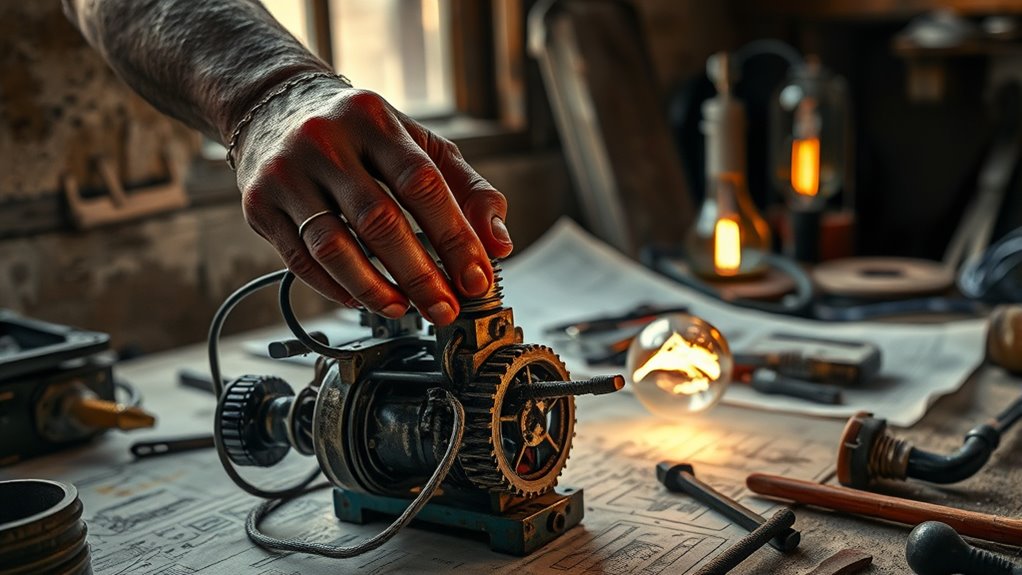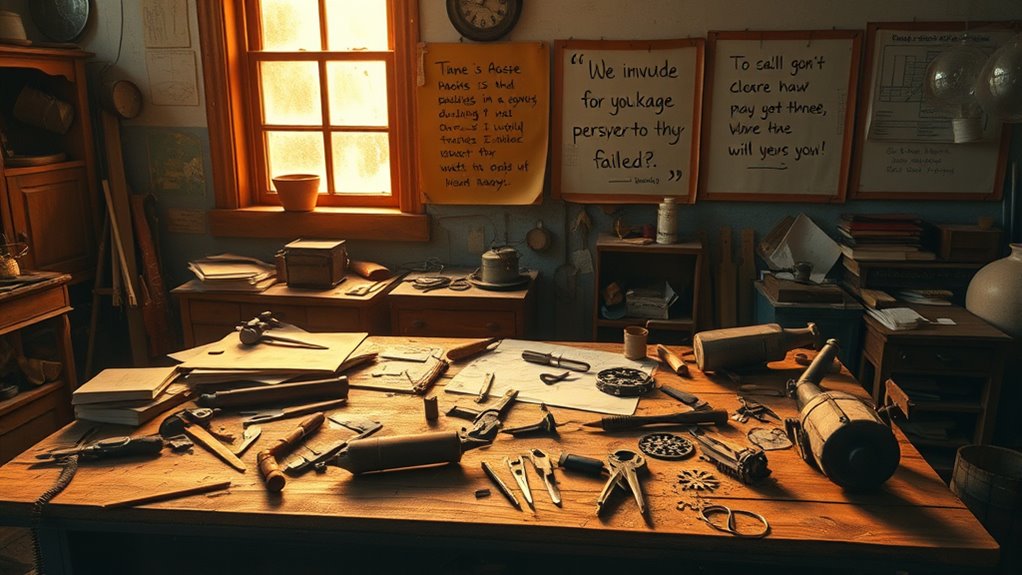Many inventors see failures as essential steps toward success, not setbacks. Thomas Edison famously said he found “10,000 ways that won’t work,” emphasizing persistence. Nikola Tesla believed faults are part of growth, and Marie Curie highlighted how setbacks point to future opportunities. By embracing mistakes and staying resilient, you turn challenges into fuel for innovation. Keep exploring these inspiring insights, and discover how embracing failure can lead to your breakthroughs.
Key Takeaways
- View setbacks as essential learning opportunities that bring you closer to success.
- Embrace failures as part of the creative process, not as defeats or endpoints.
- Cultivate resilience and persistence to transform setbacks into motivation and progress.
- Recognize mistakes as integral to growth, fostering a mindset of curiosity and continuous improvement.
- Focus on future possibilities and solutions, using failures as stepping stones for innovation.

Throughout history, inventors have faced countless challenges and setbacks, yet their words often reveal the resilience and determination that fueled their innovations. When you encounter creative setbacks, it’s easy to feel discouraged or question your abilities. But successful inventors understand that setbacks are not the end—they’re part of the process. Adopting an innovation mindset means viewing failures as opportunities to learn and grow. Thomas Edison famously said, “I have not failed. I’ve just found 10,000 ways that won’t work.” His perspective encourages you to see mistakes not as defeats but as stepping stones toward success. Every setback reveals what doesn’t work, bringing you closer to what does.
As you push forward, remember that resilience is key. Inventors like Edison didn’t achieve breakthroughs overnight; instead, they persisted through repeated failures. When you face obstacles, remind yourself that setbacks are temporary and necessary for growth. Edison’s words highlight that persistence and a positive outlook turn failures into fuel. Embracing an innovation mindset helps you stay motivated, even when progress seems slow or uncertain. Every “no” or “not yet” pushes you to refine your ideas and approach, transforming frustration into a catalyst for improvement.
Many inventors have spoken about the power of perseverance. Nikola Tesla believed in the importance of unwavering dedication, stating, “Our virtues and our faults are inseparable, like force and matter. When they separate, man is no more.” His words remind you that even your faults and failures are integral to your journey. Instead of hiding from mistakes, confront them head-on, learn from them, and use them to fuel your next move. This mindset shifts your perspective from fear of failure to curiosity and resilience.
Inspiration often comes from embracing the challenge. Inventors like Marie Curie recognized that setbacks could lead to breakthroughs. She once said, “One never notices what has been done; one can only see what remains to be done.” This outlook encourages you to focus on future possibilities rather than past failures. When you maintain an innovation mindset, you see setbacks as opportunities to innovate anew, refine your approach, and ultimately succeed. Additionally, understanding the role of contrast ratio in image quality can help you better evaluate visual clarity and depth in your projects. Remember, every great invention was born from persistent effort overcoming creative setbacks. Your resilience, fueled by the wisdom of those who came before, will turn failures into the foundation of your success.
Frequently Asked Questions
How Can Setbacks Be Transformed Into Creative Opportunities?
When setbacks happen, you can embrace them as opportunities to develop your creative resilience and strengthen your innovation mindset. Instead of seeing failures as obstacles, view them as lessons that spark new ideas and solutions. By staying adaptable and open to experimentation, you turn challenges into stepping stones. This mindset helps you discover innovative approaches, fueling your growth and encouraging continuous improvement, ultimately transforming setbacks into powerful catalysts for success.
What Mindset Shifts Help Inventors Persevere Through Failures?
Imagine you’re a modern-day Leonardo, embracing failures as lessons. To persevere, shift your mindset to see risk-taking as essential, not risky. Cultivate resilience by viewing setbacks as stepping stones, not dead ends. Remember, every failure fuels your creativity and growth. Embrace failures with curiosity and confidence, knowing that resilience and a willingness to take risks will turn obstacles into opportunities for innovation and success.
Are There Common Traits Among Successful Inventors Facing Repeated Failures?
When facing repeated failures, you’ll notice successful inventors often share traits like failure resilience and an innovation mindset. You remain persistent, viewing setbacks as opportunities to learn rather than defeats. Your ability to adapt quickly and stay optimistic fuels continual progress. These traits help you keep pushing forward, turning failures into stepping stones. Embracing failure resilience and fostering an innovation mindset are key to transforming setbacks into breakthrough innovations.
How Do Inventors Maintain Motivation After Multiple Unsuccessful Attempts?
You might feel like giving up after countless setbacks, but with an innovation mindset, you can see failure as a stepping stone, not a wall. Resilience strategies keep your fire burning—reminding you that every stumble gets you closer to success. Stay focused, learn from mistakes, and push forward. Remember, the greatest inventors turned failures into fuel, proving that persistence transforms setbacks into breakthroughs.
What Practical Steps Can Aspiring Inventors Take to Turn Failures Into Success?
To turn failures into success, you should use brainstorming techniques to generate new ideas and perspectives after setbacks. Embrace risk management by evaluating and minimizing potential losses, which keeps you motivated and resilient. When you view failures as learning opportunities, you stay focused and motivated. Keep refining your approach, stay persistent, and remember that each mistake is a step closer to your ultimate invention.
Conclusion
Remember, each failure is like a cracked seed that, when nurtured, blooms into a vibrant new idea. Just as a phoenix rises from its ashes, your setbacks fuel your growth and innovation. Embrace the cracks—they hold the potential for new beginnings. Every stumble is a stepping stone, transforming obstacles into opportunities. Keep your eyes on the horizon, knowing that your perseverance is the key to turning setbacks into the sparks that ignite your greatest achievements.










